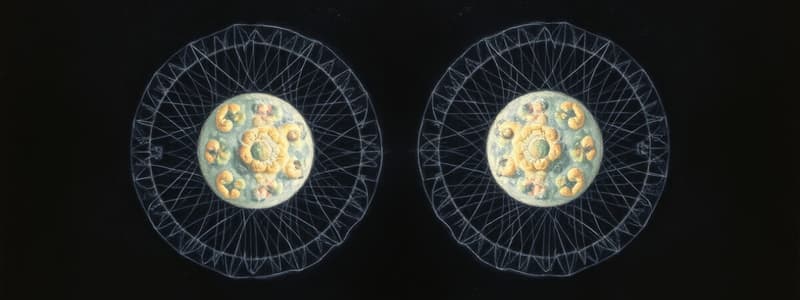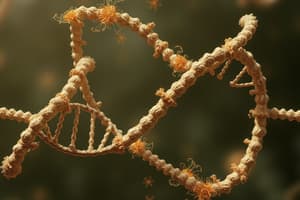Podcast
Questions and Answers
What are sister chromatids?
What are sister chromatids?
- Paired chromosomes
- Copies of a duplicated chromosome (correct)
- Identical chromosomes
- Unpaired chromosomes
What is a centromere?
What is a centromere?
Attachment point of two sister chromatids
Define interphase.
Define interphase.
Period of cell cycle when the cell is not physically dividing.
What are growth factors?
What are growth factors?
What is a cyclin?
What is a cyclin?
What is apoptosis?
What is apoptosis?
Define cancer.
Define cancer.
What is mitosis?
What is mitosis?
What is meiosis?
What is meiosis?
Define homologous chromosomes.
Define homologous chromosomes.
What does diploid mean?
What does diploid mean?
What does haploid mean?
What does haploid mean?
Define autosomes.
Define autosomes.
What are sex chromosomes?
What are sex chromosomes?
Define gamete.
Define gamete.
What is a somatic cell?
What is a somatic cell?
What is crossing over?
What is crossing over?
What is the Chromosomal Theory of Inheritance?
What is the Chromosomal Theory of Inheritance?
Define zygote.
Define zygote.
What does true-breeding mean?
What does true-breeding mean?
What is the P generation?
What is the P generation?
Define F1 generation.
Define F1 generation.
What is the F2 generation?
What is the F2 generation?
What is a hybrid?
What is a hybrid?
Define allele.
Define allele.
What is genotype?
What is genotype?
Define phenotype.
Define phenotype.
What does heterozygous mean?
What does heterozygous mean?
Define homozygous.
Define homozygous.
What is the Law of Segregation?
What is the Law of Segregation?
What is the Law of Independent Assortment?
What is the Law of Independent Assortment?
Define testcross.
Define testcross.
What is a monohybrid cross?
What is a monohybrid cross?
Define dihybrid cross.
Define dihybrid cross.
Study Notes
Chromosomes and Cell Division
- Sister chromatids are duplicate copies of a chromosome, joined at the centromere.
- Centromeres serve as the attachment points for sister chromatids.
- Interphase consists of growth (G1), DNA replication (S), further growth and preparation for division (G2), and a quiescent state (G0).
Cell Cycle Regulation
- Growth factors are proteins that promote cell division; an example is platelet-derived growth factor (PDGF).
- Cyclins are proteins that regulate cell cycle progression by activating cyclin-dependent kinases (Cdks).
Cell Death and Cancer
- Apoptosis is a programmed method of cell death that helps remove damaged cells.
- Cancer is characterized by uncontrolled cell division and invasiveness.
Mitosis and Meiosis
- Mitosis is the process of nuclear division resulting in two genetically identical daughter cells, comprising four stages: prophase, metaphase, anaphase, and telophase.
- Meiosis generates gametes in sexually reproducing organisms, involving two rounds of division and producing four haploid cells.
Chromosome Types and Gametes
- Homologous chromosomes are pairs that share the same size and shape, containing genes for the same traits.
- Diploid cells (2n) possess a complete set of paired chromosomes, typically found in somatic cells.
- Haploid cells (1n) have unpaired chromosomes, present in gametes.
Chromosomal Structures and Genes
- Autosomes are all chromosomes excluding sex chromosomes, while sex chromosomes determine gender (XX for females, XY for males).
- Gametes are reproductive cells, derived during meiosis, with a haploid number of chromosomes.
- Somatic cells are body cells generated through mitosis, containing a diploid number.
Genetic Processes
- Crossing over involves the exchange of genetic material between homologous chromosomes, increasing genetic diversity.
- The Chromosomal Theory of Inheritance states that genes are inherited through chromosomes.
Inheritance Patterns
- Zygotes are diploid cells formed from the fusion of haploid gametes during fertilization.
- True-breeding organisms consistently produce offspring with the same traits through self-pollination and are homozygous.
Generational Concepts
- P generation refers to the true-breeding parent organisms; F1 generation consists of hybrid offspring from the P generation, while F2 generation results in a phenotypic ratio of 3:1 from a hybrid cross.
Genetic Terminology
- Hybrids are heterozygous individuals possessing different alleles for a trait.
- Alleles are variant forms of a gene, denoted as A or a.
- Genotype represents an individual’s genetic composition; phenotype refers to the observable physical traits.
- Heterozygous individuals carry different alleles (e.g., Aa), whereas homozygous individuals possess identical alleles (e.g., AA or aa).
Mendelian Laws
- The Law of Segregation states that allele pairs separate during gamete formation, leading to distinct gametes.
- The Law of Independent Assortment asserts that each pair of alleles segregates independently during gamete formation, allowing for independent inheritance of traits.
Breeding Methods
- Testcross involves crossing an organism with a recessive individual to determine genotype.
- Monohybrid crosses between heterozygous individuals yield a 3:1 dominant to recessive phenotype ratio.
- Dihybrid crosses between heterozygous organisms for two traits yield a 9:3:3:1 phenotype ratio.
Polygenic Inheritance
- Polygenic traits are influenced by multiple genes, contributing to the continuous variation observed in phenotypic expressions.
Studying That Suits You
Use AI to generate personalized quizzes and flashcards to suit your learning preferences.
Description
Test your knowledge on heredity concepts in AP Biology with these flashcards. Each card covers important terms and definitions related to chromosomes and the cell cycle stages. Perfect for quick review and effective memorization.




